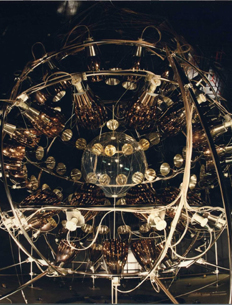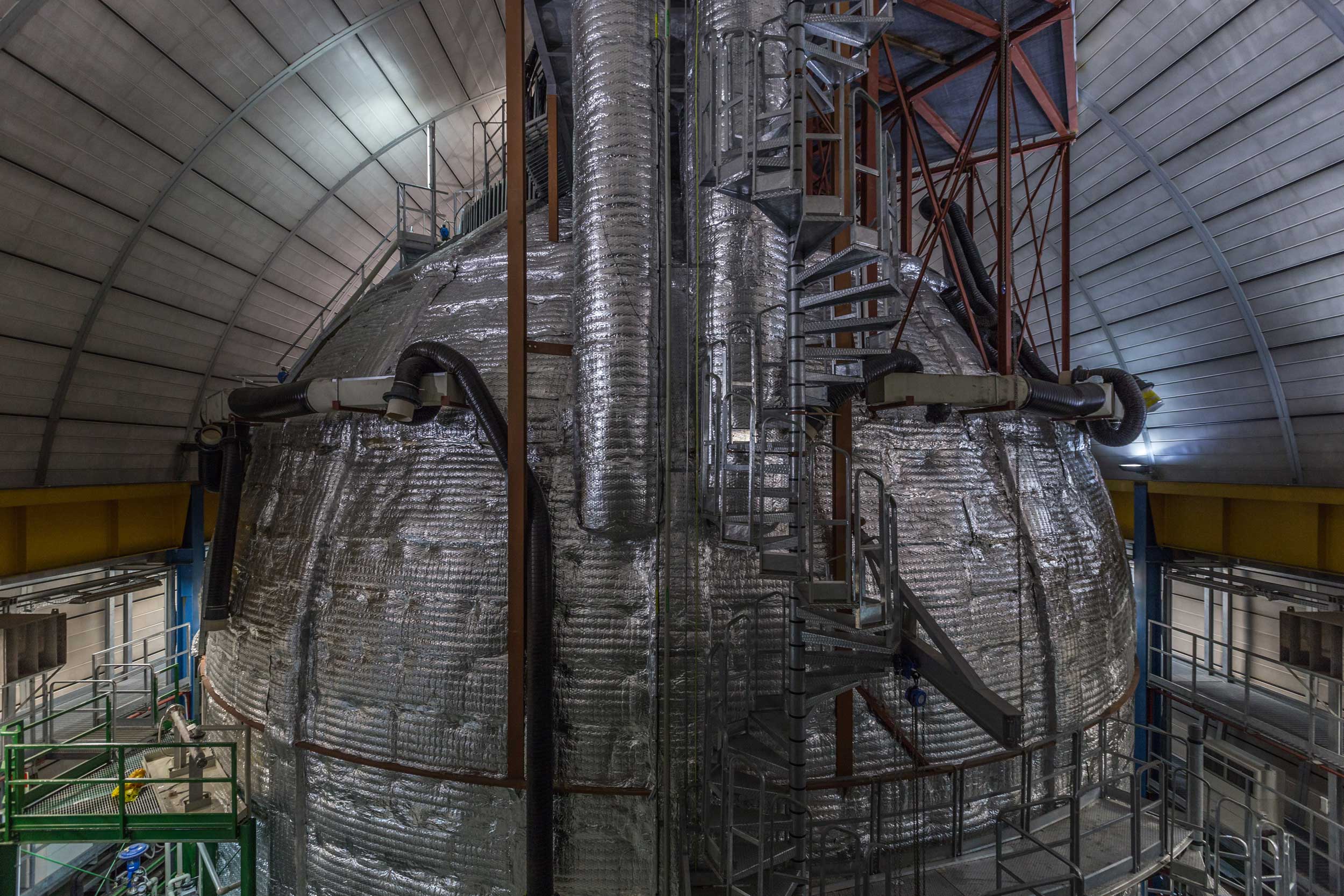About awarding prize of European Physical Society to Borexino collaboration
Interview, 07 July 2021
“The needle is in an egg, the egg is in a duck, the duck is in a hare, the hare is in a chest”, this fairy tale imagery is evoked when one thinks of the detector structure of the Borexino experiment. The nylon vessel with a radius of 4 m contains almost 300 t of liquid scintillator. The stainless-steel sphere with a radius of 8.5 m encloses it. About 700 t of buffer fluid is between the nylon bag and the sphere. The entire construction is immersed into the tank with 2.5 t of ultrapure water. The detector itself is shielded by the massive Italian mountain Gran Sasso.
What for is this detector needed, what does it study, and for which research was the Borexino collaboration recently awarded the prestigious Giuseppe and Vanna Cocconi Prize?
 We spoke about all this with Oleg Yurevich Smirnov, the senior DLNP researcher, the head of the Borexino group at JINR.
We spoke about all this with Oleg Yurevich Smirnov, the senior DLNP researcher, the head of the Borexino group at JINR.
The Cocconi Prize is awarded biennially for outstanding experimental, theoretical, or technological contribution to astroparticle physics and cosmology.
This is the sixth award in the Prize history. In 2017, Rainer Weiss, Kip Thorne, and Barry Barish received the Nobel Prize in physics just several months after they had got the Giuseppe and Vanna Cocconi Prize. The same goes for Arthur MacDonald who received the Cocconi Prize in 2013 and then, two years afterward, the Nobel Prize.
Now, the Prize is awarded to scientists of the Borexino collaboration. Why was their research so valuable? What results did they obtain?
The idea of the experiment originated as far back as 1988. Solar neutrinos moving in ultrapure liquid — scintillator — can be detected through light flashes accompanying interactions between neutrinos and matter. To “see” these weak light flashes, it is necessary to get rid of radiation of any kind, inside and outside the detector, otherwise, the detector will “glow” on its own. At the very beginning, scientists planned to use a boron-containing fluid and to detect, among others, “boron” neutrinos released in B-8 decay reactions in the Sun. So, the experiment was named “Borexino” from BorEx — a boron experiment. The initial ambitious project suggested using 50 thousand tonnes of liquid scintillator as a target for neutrinos. And since the implementation of such a project would be extremely labour-intensive, it was decided to construct a detector with a smaller mass. At present, there are only 300 t of liquid scintillator, and that is why the diminutival “-ino” appeared in the name of the experiment. Later, it was decided to refuse using a quite dangerous liquid with boron and to switch to pseudocumene (for chemists — 1, 2, 4-trimethylbenzene whose molecule is similar in structure to that of ordinary benzine), but by that time, the name was already stuck to the experiment and therefore kept. The main goal of the experiment remained to detect solar monoenergetic neutrinos from beryllium reactions (beryllium neutrinos).
To implement the experiment, an ultrapure medium free of any radioactive impurities is needed. The expected number of neutrino events in 100 t of the target is only 50 events per day. Radioactivity of regular potable water is up to one decay per second in one litre. If we calculate this for 100 t, we will get about 100 billion events per day. Therefore, regular potable water which nobody will call radioactive is an extremely radioactive medium from the perspective of the Borexino experiment. At the time when the detector project was proposed, it was uncertain whether the required level of scintillator purity could be achieved. In 1995, a four-tonne prototype of the CTF detector was put into operation. It demonstrated a basic possibility of both purifying the scintillator and constructing a larger facility. Till 2011, the CTF was in use as a high-sensitivity instrument to control the liquid scintillator radioactivity level. The Borexino detector, launched in 2007, is still in operation. Much time passed by from concept elaboration to implementation, but the idea was complicated. As a result, the outcome during project realization was much greater than it was intended at the very beginning.
 We, together with Oleg Yurevich Smirnov, discuss the structure of the Borexino detector in all details. The fairy-tale “chest” is a massive Gran Sasso mountain in Italy where in 1982, the construction of the world’s largest underground laboratory got underway in parallel with a road tunnel. The laboratory was intended for physics experiments with strict requirements for shielding against cosmic rays. The Borexino detector is placed in one of three lab halls. The rock mass of more than one kilometre protects the detector against cosmic particle fluxes and does not emit radiation like, e.g., granite. The high-purity water layer and pseudocumene buffer in the detector serve as additional shielding against gamma radiation and neutrons from the environment and detector materials. All the structural components were checked for radioactivity, and when possible, materials with their minimum content were chosen. The general rule kept up in the detector was “the nearer the centre, the purer the materials”.
We, together with Oleg Yurevich Smirnov, discuss the structure of the Borexino detector in all details. The fairy-tale “chest” is a massive Gran Sasso mountain in Italy where in 1982, the construction of the world’s largest underground laboratory got underway in parallel with a road tunnel. The laboratory was intended for physics experiments with strict requirements for shielding against cosmic rays. The Borexino detector is placed in one of three lab halls. The rock mass of more than one kilometre protects the detector against cosmic particle fluxes and does not emit radiation like, e.g., granite. The high-purity water layer and pseudocumene buffer in the detector serve as additional shielding against gamma radiation and neutrons from the environment and detector materials. All the structural components were checked for radioactivity, and when possible, materials with their minimum content were chosen. The general rule kept up in the detector was “the nearer the centre, the purer the materials”.
A stainless-steel vessel is immersed into water. There are 2200 photomultiplier tubes mounted on it viewing the scintillator in the nylon vessel. Thanks to the analysis of the arrival time of signals from individual photomultipliers, the interaction point in the detector can be determined. This information allows using the outer scintillator layer for protection against radioactivity which is present in the vessel although less than that of nylon we use in our everyday life. Ultimately, an area with a radius of 3 m and a mass of about 100 t is used for data analysis. The rest of the facility has to shield this area from different types of radioactivity. It is safe to claim that the central part of the Borexino detector is the “purest” place on the Earth considering radioactivity.
Such a detector structure ensures that only neutrinos with incredible penetrability can reach the working volume of the scintillator through all protection layers. That means that high-precision measurements of neutrino fluxes can be performed and other rare processes investigated.
What was achieved during all these years?
Physicists have examined the beryllium neutrino flux from the Sun and studied seasonal and daily variations of neutrino fluxes. Seasonal variations in neutrino fluxes arise from the difference in the distance to the Sun in winter and summer and can be well identified in the Borexino data confirming the solar origin of the signal. Daily variations could be related to neutrinos going through the Earth at night, but they were not observed, which agrees with modern data in neutrino physics. Both measurements were originally specified in the programme. A number of measurements were performed above the programme, including determination of fluxes of almost all neutrinos from pp-chain reactions, and “boron” neutrinos as well.
For the first time, neutrinos from the pep reaction, an alternative beginning of the pp-chain reaction, were observed.
Electron stability was checked. Strict limits on the permissible magnetic moment of solar neutrinos were obtained. Other rare processes were investigated, e.g., antineutrino released by the Earth’s interior (geoneutrinos) was proved for the first time.
The research results indicated that the solar model with a high concentration of elements heavier than helium is more possible than the alternative model, which is a crucial step forward in exploring the chemical composition of the Sun, or so-called “solar metallicity” (astrophysicists call all the elements heavier than helium “metals”). Eventually, the scientists measured the neutrino flux from the CNO cycle. In 2020, the results of these measurements were published in Nature (https://www.nature.com/articles/s41586-020-2934-0). They could not pass unnoticed by the science community, and the award is a consistent research outcome.
Oleg Yurevich also talked about the role of the JINR group in the experiment. “When the experiment just started, the responsibility of the Dubna physicists was photomultiplier tubes and the data taking system for the prototype detector. Each of 2200 devices was tested by our testers. A great deal of work was done — a Dark Room was equipped for photomultiplier testing at Gran Sasso, operational characteristics of these devices were examined,” explained he. “While working on the CTF detector, our scientists switched to solving physics tasks — several articles on the results of the search for rare processes in the CTF data were published by the Dubna group. After the launch of the Borexino detector, the DLNP group contributed a lot to the fulfillment of the main objective of the experiment — the separation of beryllium neutrino interactions from the data set. Our scientists were also actively involved in other data analyses, first of all in measurements of the pp-neutrino flux and search for rare processes, including electron decay and interactions due to neutrino magnetic moment. The data analysis is still going on. We plan to improve the results by analyzing the total set of available data.”
What is Borexino’s future?
РThe detector will have to end its operation in the foreseeable future. One of the reasons is protests of local environmental activists who consider the experiment potentially dangerous for the surroundings because of liquid scintillator toxicity. Even radiation is feared, though the detector is safe in this respect.
The detector is scheduled to be “turned off” on 1 September 2021 although the pandemic can correct the plans — dismounting was already postponed several times. The detector shutdown does not mean the end of the experiment — the data obtained and being taken now will be processed during the next years. That is, new results and new conclusions are in store for the scientists.
The Prize awarding ceremony will take place on 26 July.
Congratulations to our colleagues on this appreciation! We wish them further success in their scientific work!
Source: DLNP JINR
